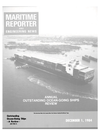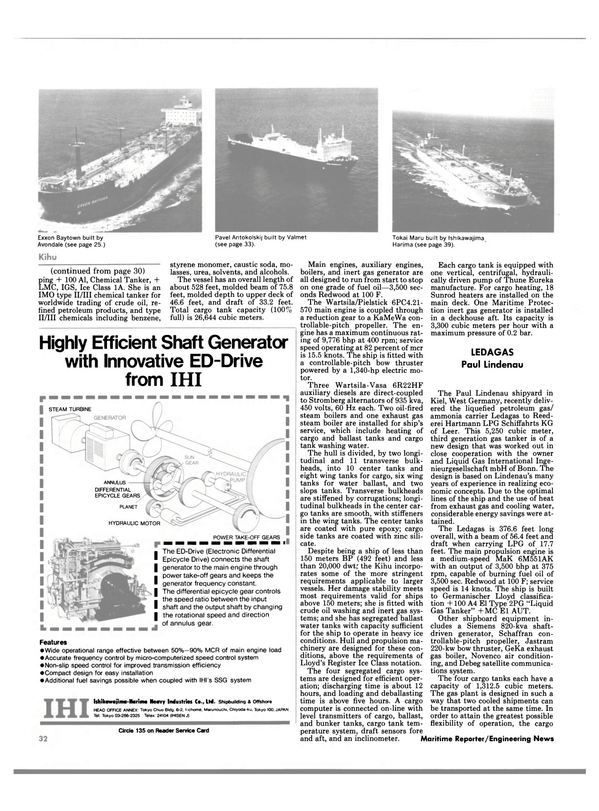
Du Pont's Maintenance Painting Service Lowers Costs On Offshore Platforms
After building a 12-year onshore success record, Du Pont has moved its cost-reducing Maintenance Painting Service (MPS) offshore to oil drilling and production platforms and other marine structures.
In the past two years, Du Pont's Offshore MPS (OMPS) has helped Conoco Oil's New Orleans Division cut maintenance painting costs by 25 percent at its Grand Isle offshore production platforms in the Gulf of Mexico. At the invitation of Du Point, Maritime Reporter and Engineering News recently visited several Conoco platforms to view the procedure and the results (photos).
Conoco officials credit the reduction to the systematic OMPS program, which combines tight management controls with flexible scheduling to cover contingencies such as weather and platform operating emergencies.
Working with Conoco's New Orleans Division, OMPS specialists prepared a program for painting 75 platforms in a 600-square-mile area to specific coverage standards at a guaranteed price that, according to Du Pont, turned out 15 percent below Conoco's lowest cost in the past 20 years. OMPS offshore operations manager Gene Ivey reports that 25 platforms were painted on schedule at a lower cost than estimated.
Du Pont will adjust the contract accordingly.
"Offshore painting is three to five times more expensive than onshore painting," Mr. Ivey said. "Weather and water conditions and operating emergencies can affect scheduling, and rigging is more complicated and time-consuming. Because labor is the most expensive component of a painting program, we kept costs down by using highly qualified, efficient painting contractors and by planning backup work in case of emergencies or weather problems," he said.
Du Pont built its MPS success on the combination of its ability to manage maintenance painting projects for quality within prescribed deadlines and budgets, and for its technological expertise in preparation and painting of production facilities.
In the past 18 years, Du Pont has saved as much as 60 percent in maintenance painting of its production facilities, which represent a capital investment of more than $10 billion. Du Pont began offering MPS to chemical and industrial production facilities 12 years ago, and its success prompted the company to look offshore for another outlet for the service.
"We felt that our expertise in controlling corrosion and in managing painting contracts would work offshore, and the Conoco program seems to confirm that," said Jack Jones, OMPS marketing manager.
"As the managing partner of the Grand Isle Project, Conoco had to consider the interests of other owners in getting the best performance at the lowest price," said E.L. Moffatt, division production superintendent.
"The entire program is geared to efficient planning and management.
We surveyed the corrosion levels and painting needs of all of our platforms with the OMPS people to match critical areas with production priorities and locations. This gave us primary areas and backup areas, which is something previous painting contractors didn't do. As a result, we are able to have something painted even if painters have been working in an area where a production emergency occurs. That's been a key factor in keeping our program on schedule and within budget," Mr. Moflfatt said.
Predictability, accountability, and protection are the cornerstones of OMPS. Du Pont assumes the responsibility for painting platforms and other marine structures at an agreed-upon level of protection and/or appearance for an extended period at a predetermined fee, subject only to change in labor rates and material costs. The annual price for the first five years will be at or below the price quoted by Du Pont before the program begins.
OMPS consists of preparations, finishing, and inspection. It includes all vessels, structural steel, walkways, piping, and all the surfaces constantly exposed to deterioration from weather, corrosion, and wear and tear. OMPS specialists devote full-time attention to planning, scheduling, supervision, monitoring, and follow-up. This regimen is necessary to keep a job on target.
Offshore painting can run $5 to $6 per square foot, sometimes going as high as $12 in hard-to-paint spots.
This is an average of three to five times higher that the cost of landbased painting programs, and most of the cost is labor-related, especially for rigging. OMPS is investigating a rigging method that involves rigging an entire platform leg at one time, which has great promise of reducing labor significantly, and a non-painting technique for protecting platform splash zones.
Along with technological advances, only safety-conscious, highly productive contractors are selected before work begins. In addition to being productive and reliable, contractors hired by OMPS must be able to furnish work crews capable of performing under difficult marine conditions.
Once work begins, OMPS managers hold periodic reviews with facility managers and technical personnel to stay current with their changing needs and to assess the program's progress relative to objective.
Additional Services Based on its offshore success, OMPS is extending its inspection and monitoring to integrate cathodic protection services with painting for complete structure protection.
With 15 years of cathodic protection experience, Du Pont will apply the same approach used for painting.
Specialists will survey and analyze existing cathodic protection systems and develop a planned retrofitting program for optimum continuous protection. Du Pont will design, engineer, and install all anodes and continuously monitor and inspect them.
With its expanded services, OMPS is preparing to extend the geographic range of its operations into the North Sea.
For a free 12-page color brochure on Du Pont's OMPS, Circle 65 on Reader Service Card
Read Du Pont's Maintenance Painting Service Lowers Costs On Offshore Platforms in Pdf, Flash or Html5 edition of December 1984 Maritime Reporter
Other stories from December 1984 issue
Content
- Midland Affliated Co. Agrees In Principle To Acquire Federal Barge page: 5
- Webb Elects Officers To Governing Board— Bryan Named President page: 5
- Brown Brothers Appoint New Marketing Director page: 5
- Hyundai's $18-Million Maritime Research Institute In Ulsan Completed page: 6
- Huthnance Corporation Formed To Consolidate Rig Ownership page: 6
- Brochure On Halon 1301 Fire Extinguishing Systems Offered By Walter Kidde page: 6
- Bay Ship Converts NavAids Barge For U.S. Coast Guard page: 6
- Annual Conference Of CSSRA Scheduled For February 18-19, 1985 page: 6
- $425-Million Rig Expansion Program Announced By Sonat page: 7
- Krupp MaK Reports On Sales Of M 5 5 1 / M 5 52 Series Diesel Engines page: 7
- Lindenau Yard Delivers Seismic Research Vessel To Western Geophysical page: 7
- NMEA Plans to Expand Electronics Technician Certification Program page: 7
- Hose-McCann Introduces Dial Telephone System page: 7
- Peterson Builders Lays Keel For Second Of Three Mine Countermeasure Ships page: 8
- Eastern Marine Delivers Towboat —Ninth of A 10-Vessel Contract page: 8
- USCG License Preparation Quicker And Easier With Computer-Aided System page: 8
- Seebeckwerft Delivers World's Largest Railway/Car Ferry page: 8
- Magnavox Announces First Fully Automatic Vessel Monitoring System page: 8
- Magliocca Elected New General Chairman Of NSC Marine Section page: 9
- BFGoodrich Offers New Brochure On Cutless Line Of Rubber Bearings page: 9
- New Industrial Mixer Seals By EG & G Sealol page: 10
- $2.8-Million Contract To Tacoma Boat Has $97.5-Million Potential page: 10
- Training Success With U.S. Rig Simulator Featured At Conference page: 10
- Borum Wins Kings Point Outstanding Professional Achievement Award page: 10
- Desco Marine Chosen To Build 107-Foot Steel Fishing Boat page: 11
- Marine Consultants' Society Hears Paper On An Attorney's View page: 11
- Offshore Shipbuilding Delivers Passenger/Vehicle Ferry page: 11
- Exxon Research Offers To License Computerized Machine Analysis System page: 11
- OUTSTANDING OCEANGOING SHIPS OF 1984 page: 12
- Marine Applications Book Availble From Sandusky page: 13
- Avondale Shipyards Holds Keel-Laying Ceremonies For First Of Four Navy Fleet Oilers page: 13
- Robins Named Managing Director-Business Operations At Rolls-Royce page: 13
- Containership 'Merzario Britannia' Launched At Fincantieri Yard page: 14
- N.F. Pergola Appointed Manager-Marine Personnel At Energy Transportation page: 14
- Murray Named Executive Director Of St. John Port Development Commission page: 14
- Regency Introduces The CR5000 Electronic Chart Recorder page: 14
- Operate 365 Days a Year with Greater Efficiency, Safety and Profits page: 15
- K-C Offers Literature On Replacement Parts Line For GM Diesels page: 16
- WABCO Westinghouse Offers Free Booklet On Controls For Ships page: 16
- Crouse-Hinds Offers Literature On Lighting Fixtures & Others Products page: 17
- Ursini Appointed Vice President-General Manager Of Skagit Products page: 17
- The 92nd SNAME Annual Meeting A Special Post-Meeting And Exposition Report page: 18
- Cable Splicing System Lowers Shipbuilding Costs page: 23
- New Literature Available On VHF/FM Marine Radios From Uniden Corporation page: 26
- Hahnfeldt Appointed Power Division Sales Manager At H.O. Penn Machinery page: 26
- Todd-Los Angeles Delivers Guided Missile Frigate FFG-51 Gary To U.S. Navy page: 28
- Ryan-Walsh Appoints John McCarron Jr. Chief Executive Officer page: 28
- Koomey Announces Management Changes—Dumas Named President page: 30
- ASNE Establishes Dr. James A. Lisnyk Memorial Scholarship page: 30
- Navy Awards E-Systems $40-Million Contract page: 30
- Rexnord Announces Formation of Process Controls Division page: 30
- Du Pont's Maintenance Painting Service Lowers Costs On Offshore Platforms page: 32
- Morgan Appointed National Sales Manager For Welded Beam page: 33
- John Gaughan Named To New Maritime Post page: 33
- Taylor Joins COMSAT World Systems Division As Senior Vice President page: 34
- Todd Marine Systems Offers New Brochure On Combustion Technology page: 34
- Torpedo SPC Chosen For Advanced Cable Layer page: 34
- Corpus Christi Bulk-Loading Facility To Be Modernized page: 35
- New Full-Color Brochure Available From PACECO page: 36
- Daewoo Gets $425-Million Contract From Sonat For Six Semisubmersible Rigs page: 36
- Whalen Joins Huthnance As Vice President -Operations page: 36
- Liner Norway Fitted With New MaK-Driven Gensets page: 37
- MarineSafety Offers Radar Renewal Course page: 37
- Crosby Group Adds New Block To Product Line page: 37
- Armco's Baltimore Precision Forging Complex Now In Full Operation page: 38
- Regency Introduces Marine Television/FM Stereo Antenna And Amplifier page: 38
- Newman's Introduces NEWCO Marine Valves page: 38
- Rockwell Offers Brochure On Ship Information Management Systems page: 38
- Markey Delivers DESH-6 Electric Research Winch page: 38
- Surface Effect Ship Margaret Jill Christened In New Orleans page: 40
- Free Jered Brown Brochure Highlights Denny Brown Folding Fin Stabilizers page: 41
- C. Plath Offers Literature On NAVIGLOBE Satellite Navigation Receiver page: 43
- Free Literature Offered On Walter Kidde Marine Smoke Detection System page: 43
- Imperial Survival Suits Offered by Alexander page: 43
- Phoenix Introduces Sodium Fishing Lights page: 43
- MonArk Boat Delivers Fireboat To City Of Memphis page: 44
- Tano Corporation Offers New Brochure On Marine Automation Systems page: 44
- SNAME Announces 1985 Scholarships In Graduate And Undergraduate Levels page: 44
- Moss Point Marine Launches Supply Boat For Argosy Offshore page: 45
- Sea Float Buoys Approved By Norwegian Maritime Directorate page: 45
- Tracor Hydronautics Delivers Part Task Ship-Handling Simulator To Panama Canal Commission page: 46
- New York Section SNAME Meeting Discusses Drydock Certification page: 46
- Bethlehem Steel's Huge Drydock At New Sabine Yard In Texas To Be Operational In Spring '85 page: 47
- New Rudder-Shaft Bearing From Thomson-Gordon page: 47
- One-Day Seminar Discusses Energy-Saving Potential Of A-C Variable Speed Drives For Shipboard Application page: 51
- Dillingham Maritime Delivers Building Modules To Valdez For Transport To North Slope page: 55
- ASEA Hagglunds Establishes New Division For Marketing Cargo Cranes In The U.S. page: 55
- Southwest Marine Awarded Two Contracts Worth $2.8-Million page: 55
- Videoteleconferencing Systems To Be Built By COMSAT General page: 55


